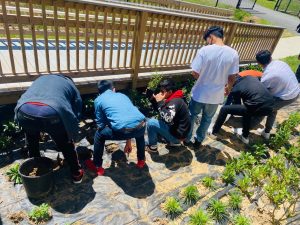In spring 2022, Unity Gardens funded 17 projects in amounts from $300 to $3000, totaling over $20,000 in trees, shrubs, grasses, and perennials planted by volunteers exclusively in Anne Arundel County.
Explore our spring 2022 grantee projects below!
Anne Arundel Community College | Belvedere Pollinator Sensory Garden | Chartwood Community Association
Chase Creek Swim Club | Chelsea Beach | Colchester Community | Crain West | Hatton-Regester Green
Loch Haven | Monarch Academy | North County High School | Severn Grove Improvement Association
Severna Park Community Center
Anne Arundel Community College
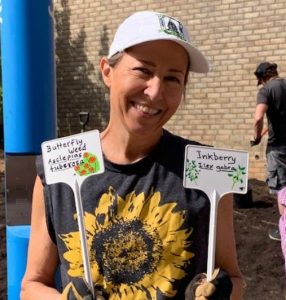 Students from Anne Arundel Community College’s Biology and Environmental Club initiated a project to convert a decades-old English ivy bed into a pollinator garden, in hopes of creating a Monarch butterfly waystation. Under the supervision of Dr. Susan Lamont, Professor of Botany, a group of eight students first removed weeds and debris from the bed. On planting day, students and faculty from Landscape Architecture as well as AACC’s plant science courses (including Botany, Plant Propagation and Sustainable Horticulture) helped plant a dozen native trees, shrubs, and perennials, including a Red Bud tree, New Jersey Tea, milkweed, goldenrod, Joe Pye weed, Black-eyed Susan and more.
Students from Anne Arundel Community College’s Biology and Environmental Club initiated a project to convert a decades-old English ivy bed into a pollinator garden, in hopes of creating a Monarch butterfly waystation. Under the supervision of Dr. Susan Lamont, Professor of Botany, a group of eight students first removed weeds and debris from the bed. On planting day, students and faculty from Landscape Architecture as well as AACC’s plant science courses (including Botany, Plant Propagation and Sustainable Horticulture) helped plant a dozen native trees, shrubs, and perennials, including a Red Bud tree, New Jersey Tea, milkweed, goldenrod, Joe Pye weed, Black-eyed Susan and more.
Belvedere Pollinator Sensory Garden
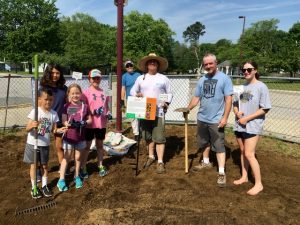 Belvedere Elementary School in Arnold recently used a Unity Gardens grant to help fund a pollinator garden to increase natural habitat on the grounds as well as to create an additional outdoor area to learn about local pollinators, wildlife and native plant species. The new garden includes a sensory path to encourage outdoor sensory exploration – especially fun with shoes off. In addition, this garden beautifies a high traffic entrance while increasing water absorption and decreasing polluted runoff to the storm drain and Broad Creek. Belvedere is always working to maintain their “Certified Green School” status, and this garden is a wonderful part of their ongoing green actions.
Belvedere Elementary School in Arnold recently used a Unity Gardens grant to help fund a pollinator garden to increase natural habitat on the grounds as well as to create an additional outdoor area to learn about local pollinators, wildlife and native plant species. The new garden includes a sensory path to encourage outdoor sensory exploration – especially fun with shoes off. In addition, this garden beautifies a high traffic entrance while increasing water absorption and decreasing polluted runoff to the storm drain and Broad Creek. Belvedere is always working to maintain their “Certified Green School” status, and this garden is a wonderful part of their ongoing green actions.
Chartwood Community Association
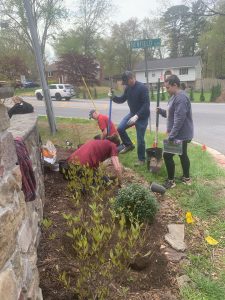 In this high profile project right on Benfield Road, the Chartwood Community Association installed two new native gardens visible to the thousands of cars that drive Benfield Road each day. The community saw the need to minimize erosion and address stormwater at its two entrances, especially the Faircastle Avenue and Benfield Blvd entrance. In addition, they wanted to add habitat. What environmental tool does all that? Native plants! They group was happy to receive a Unity Gardens grant to replace invasive species with native trees and shrubs like Viburnum, low-grow Sumac, New Jersey Tea, plus a variety of pollinator-friendly perennials. Residents performed all the work, thus engaging and educating the Chartwood Community in planting, caring for and appreciating native plants.
In this high profile project right on Benfield Road, the Chartwood Community Association installed two new native gardens visible to the thousands of cars that drive Benfield Road each day. The community saw the need to minimize erosion and address stormwater at its two entrances, especially the Faircastle Avenue and Benfield Blvd entrance. In addition, they wanted to add habitat. What environmental tool does all that? Native plants! They group was happy to receive a Unity Gardens grant to replace invasive species with native trees and shrubs like Viburnum, low-grow Sumac, New Jersey Tea, plus a variety of pollinator-friendly perennials. Residents performed all the work, thus engaging and educating the Chartwood Community in planting, caring for and appreciating native plants.
Chase Creek Swim Club
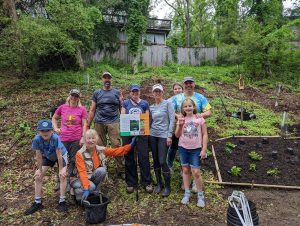 For over 50 years, the Chase Creek Swim Club has been nestled in a low lying spot that collects rainwater runoff. And in recent years, bamboo has begun to plague the spot as well. This year, pool leadership decided to take on the ever-growing invasive species and tackle rainwater management at the club. After consulting with a Watershed Steward, they decided to begin by professionally removing bamboo, and to reroute a bare dirt path that goes directly straight down from the top of a slope to the bottom– an easy route for rainwater to travel further eroding the hillside. The new path is more gradual and has native plantings lining the path to slow and spread the rainwater allowing it to soak into our soil instead of eroding the hillside. A dozen+ volunteers came out to remove debris and invasives and plant native shrubs on the slope, including varieties of viburnum, low grow sumac, spicebush, and clethra. In addition, a pollinator garden was added near the pool entrance to help educate visitors.
For over 50 years, the Chase Creek Swim Club has been nestled in a low lying spot that collects rainwater runoff. And in recent years, bamboo has begun to plague the spot as well. This year, pool leadership decided to take on the ever-growing invasive species and tackle rainwater management at the club. After consulting with a Watershed Steward, they decided to begin by professionally removing bamboo, and to reroute a bare dirt path that goes directly straight down from the top of a slope to the bottom– an easy route for rainwater to travel further eroding the hillside. The new path is more gradual and has native plantings lining the path to slow and spread the rainwater allowing it to soak into our soil instead of eroding the hillside. A dozen+ volunteers came out to remove debris and invasives and plant native shrubs on the slope, including varieties of viburnum, low grow sumac, spicebush, and clethra. In addition, a pollinator garden was added near the pool entrance to help educate visitors.
Chelsea Beach
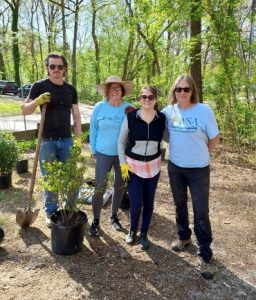 The Chelsea Beach Resident’s Association in Pasadena recently used a Unity Gardens grant to continue their Playground Revitalization Project with the planting of native trees, shrubs and perennials in three areas of the community playground. The community expressed an interest in planting a native garden that would beautify the playground, support pollinators, control storm water runoff and could realistically be maintained by a volunteer association. The variety of native plants that were chosen will support pollinators with flowering shrubs in the spring followed by flowering perennials in summer and fall. The densely planted trees, shrubs and ferns along the slopes along the back of the playground will prevent erosion into Cockey Creek which flows into the Magothy River. Low shrubs and ferns will also provide ample ground cover to encourage weed suppression.
The Chelsea Beach Resident’s Association in Pasadena recently used a Unity Gardens grant to continue their Playground Revitalization Project with the planting of native trees, shrubs and perennials in three areas of the community playground. The community expressed an interest in planting a native garden that would beautify the playground, support pollinators, control storm water runoff and could realistically be maintained by a volunteer association. The variety of native plants that were chosen will support pollinators with flowering shrubs in the spring followed by flowering perennials in summer and fall. The densely planted trees, shrubs and ferns along the slopes along the back of the playground will prevent erosion into Cockey Creek which flows into the Magothy River. Low shrubs and ferns will also provide ample ground cover to encourage weed suppression.
As one Chelsea Beach volunteer said, “I had no idea how important native gardens are to the local environment. Since applying for this community grant, I’ve implemented some of the practices I learned into my own home garden. I’ve seen more butterflies and birds in my yard this summer than ever before.”
Colchester Community
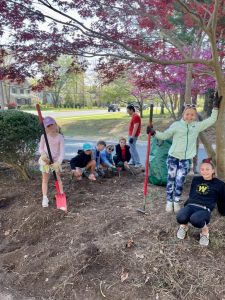 At the entrance of the Colchester Community in Severna Park, residents, visitors, and passersby were once greeted by a median garden filled with non-native species, dirt, and potential. In 2021, the community launched a garden club to rebuild a sense of community and foster environmental stewardship. As one of their first projects, the garden club revamped the entrance garden, removing invasives and planting native plants to offer year round color, decrease erosion, and create a habitat for local birds and other pollinators.
At the entrance of the Colchester Community in Severna Park, residents, visitors, and passersby were once greeted by a median garden filled with non-native species, dirt, and potential. In 2021, the community launched a garden club to rebuild a sense of community and foster environmental stewardship. As one of their first projects, the garden club revamped the entrance garden, removing invasives and planting native plants to offer year round color, decrease erosion, and create a habitat for local birds and other pollinators.
In May, community volunteers of all ages spent three weekends removing liriope and non native bushes, digging holes for larger plants, and planting over 200 native species, including beautyberry, Christmas fern, coneflower and more. Today, the garden is enjoyed by residents, those traveling on Benfield Road, and a slew of birds, moths, butterflies and bees.
Crain West
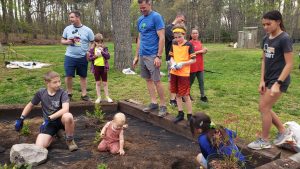 Spring has sprung in the Crain West neighborhood. In honor of Earth Day 2022, which turned out to be a warm and sunny day, volunteers of all ages got their hands in the dirt to plant native trees and flowers provided through our Unity Gardens grant. A total of 27 neighbors attended the “planting party” event in the community recreation area, where families often gather to socialize. Many trees have been removed in recent years due to the Swamp Chestnut Oak disease and the groups’ goal was to replace them with other native species so the area can be enjoyed by neighbors for years to come. Says the project organizer Meredith Memmer, “The event was a great success and we are thrilled to be a Unity Gardens grant recipient. Thank you!”
Spring has sprung in the Crain West neighborhood. In honor of Earth Day 2022, which turned out to be a warm and sunny day, volunteers of all ages got their hands in the dirt to plant native trees and flowers provided through our Unity Gardens grant. A total of 27 neighbors attended the “planting party” event in the community recreation area, where families often gather to socialize. Many trees have been removed in recent years due to the Swamp Chestnut Oak disease and the groups’ goal was to replace them with other native species so the area can be enjoyed by neighbors for years to come. Says the project organizer Meredith Memmer, “The event was a great success and we are thrilled to be a Unity Gardens grant recipient. Thank you!”
Hatton-Regester Green
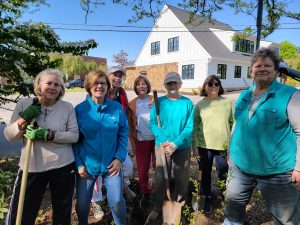 The 19-member Moonflower Garden Club recently used a Unity Gardens grant to restore and replant two areas of the Hatton- Regester Green with native plants and shrubs. Hatton-Regester Green is a landscaped park along the B&A Trail in Severna Park at the intersection of Evergreen and Holly Streets. The section of the park with the pond and garden has been an ongoing project of the Moonflower Garden Club for the past 24 years.
The 19-member Moonflower Garden Club recently used a Unity Gardens grant to restore and replant two areas of the Hatton- Regester Green with native plants and shrubs. Hatton-Regester Green is a landscaped park along the B&A Trail in Severna Park at the intersection of Evergreen and Holly Streets. The section of the park with the pond and garden has been an ongoing project of the Moonflower Garden Club for the past 24 years.
The grant was used to purchase the native perennials Butterfly weed, New England aster and Black eyed Susans and the native shrubs Winterberry Holly to restore two areas of the garden. Garden Club members removed invasive non-native grasses before planting the native plants. The selected plants will provide all-season beauty and will allow for the elimination of fertilizers and pesticides. Native plants have occurred in our region for thousands of years and are accustomed to local sun, soil, and climate. Local wildlife evolved with these plants, so they can serve as food and cover for butterflies, birds, frogs, turtles, and small mammals. The Club has now registered to have their garden added to the Maryland Pollinator Pathway.
Patrons who walk and bike the popular B&A Trail often stop at the Hatton-Regester Green to rest and enjoy the scenery. The Moonflower Garden Club members report many wonderful interactions with residents on the trail – joggers/walkers/bikers stop to express their gratitude for the beautiful garden and pond. Moonflower Garden Club members hope that the presence of attractive native plants will help to educate garden visitors about the positive contribution that native plants can make in their home gardens by supporting local pollinators, birds and wildlife.
Loch Haven
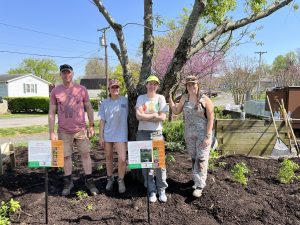 Thanks to the efforts of volunteers, the community of Loch Haven in Edgewater now has a new native garden. The garden is across the street from a living shoreline restoration project and is on a road that enjoys lots of foot traffic, providing beauty– and education thanks to a new sign– to many residents.
Thanks to the efforts of volunteers, the community of Loch Haven in Edgewater now has a new native garden. The garden is across the street from a living shoreline restoration project and is on a road that enjoys lots of foot traffic, providing beauty– and education thanks to a new sign– to many residents.
The project was spearheaded by two Maryland DNR Master Naturalists trainees who garnered community support and volunteers to remove invasives from an overlooked lot.
They explain that because the area is very marshy due to its location so close to the water, adding native plants with longer roots will aid in better water retention and allow for a decrease in stormwater run-off. For this site, they chose milkweed, bee balm, Black-eyed susan, aster and other flowering natives that are meant to add habitat.
Even during this rainy spring, they found a sunny day to bring neighbors together to plant.
Monarch Academy
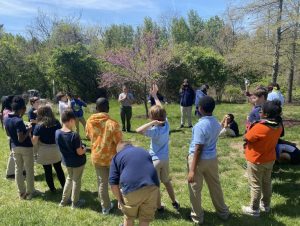 At Monarch Academy in Glen Burnie, K-5 students participate in the Adventure and Communities Program to explore the power of the natural world. Students in grades 6-8 can elect to take Earth Matters and the middle school Adventure Class. Through these curriculums, students increase confidence in the outdoors and take environmental action. In past years, students in these classes have produced an outdoor classroom, a pollinator garden, a trail system and a school-wide composting program.
At Monarch Academy in Glen Burnie, K-5 students participate in the Adventure and Communities Program to explore the power of the natural world. Students in grades 6-8 can elect to take Earth Matters and the middle school Adventure Class. Through these curriculums, students increase confidence in the outdoors and take environmental action. In past years, students in these classes have produced an outdoor classroom, a pollinator garden, a trail system and a school-wide composting program.
This spring, 23 middle-school students began planning, designing, prepping and planting a multi-year plan to replant a 280’ stream buffer on the school grounds. In collaboration with teachers, staff, and about 600 students, the site was cleared of invasive species and planted with native species including gray sedge, paw paw, swamp milkweed, New York aster, and more.
In addition to restoring biodiversity, the native landscape will serve as a future learning space for students, and they hope to propagate additional native plants in the greenhouse on campus.
North County High School
Through the Urban Agriculture program at North County High School, students planted a 300 sq ft pollinator garden on school grounds. The garden includes 17 types of native plants, including bee balm, coneflowers, tickseed, black chokeberry and more. In addition to increasing biodiversity in the local landscape, the garden provides instructional and student engagement opportunities. As part of the Urban Agriculture program, students will create an app to identify native bees and insects that visit the pollinators, harvest rainwater using a cistern, and irrigate the garden using wind and solar powered methods.
The students hope the pollinator garden will inspire the local community to replicate native plantings and sustainable maintenance methods in their own yards.
Round Bay
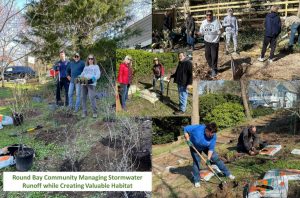 On April 9th, many members of the Round Bay Community in Severna Park enthusiastically turned out for the planting day for their “Round Bay Plants Natives” Unity Gardens project. Round Bay is situated along the historic Severn River, and the residents care deeply about the river and the health of the environment. They have an established position on their board to specifically address stormwater pollution and the management of the runoff that occurs due to the steep slopes in their community. Their project aimed to further their care of the river by planting many native flowering shrubs, perennials and ground covers on two sloped areas to create more biodiversity native flora and fauna can exist and stormwater runoff can be reduced.
On April 9th, many members of the Round Bay Community in Severna Park enthusiastically turned out for the planting day for their “Round Bay Plants Natives” Unity Gardens project. Round Bay is situated along the historic Severn River, and the residents care deeply about the river and the health of the environment. They have an established position on their board to specifically address stormwater pollution and the management of the runoff that occurs due to the steep slopes in their community. Their project aimed to further their care of the river by planting many native flowering shrubs, perennials and ground covers on two sloped areas to create more biodiversity native flora and fauna can exist and stormwater runoff can be reduced.
Residents planted native shrubs including Inkberry, Witch-hazel, Winterberry hollies, Chokeberries, Viburnums and Bayberries, and groundcovers like Bluestem goldenrod and Christmas ferns on the two sloped areas to slow runoff and prevent erosion. The plants chosen vary in height and bloom time to benefit pollinators from early spring to late fall and provide berries for birds in the winter. The dense understory layer will suppress weeds, reduce runoff and provide cover for frogs and other wildlife. Planting densely also eliminates the need to mow, saving energy and further reducing pollution.The Round Bay Community Association said “We appreciate the opportunity to contribute more of our community areas to creating habitat for our local fauna and helping to keep our rivers clean. Thank you for your generosity, Unity Gardens!”
Severn Grove Improvement Association
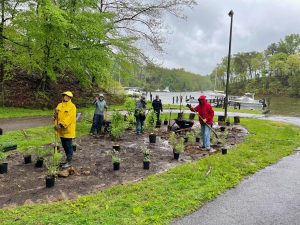 The Severn Grove Improvement Association, along the shores of Saltworks Creek in Annapolis, recently used a Unity Gardens grant to create healthier ecosystems in two of their shared common spaces. Severn Grove formed a “Native Plant Society” where members complete projects that transform parts of their grass covered community spaces into healthy native-plant ecosystems. The Severn Grove Community wanted to continue this history of environmental stewardship by planting native plants in two community spaces to create thriving native ecosystems that will support pollinators and wildlife, sequester carbon and capture storm water before it runs into Saltworks Creek. The volunteers planted a formerly turf grass area with a native Blackgum tree and with low-maintenance native shrubs, perennials and evergreen ferns including Sweetspire, Arrowwood, Shrubby St John’s Wort, Bunny Blue Hobb Sedge, Lynhaven Carpet, Christmas fern and Bluestem goldenrod. These plants will absorb runoff, deter deer, provide early food for pollinators and look beautiful. In a nearby wetland stream the volunteers removed the invasive greenbriar and non-native honeysuckle before planting native plants that attract pollinators and be an effective riparian filter for the water that flows into the creek. The trees installed include American Sycamore and Swamp Oak to absorb water, provide shade, reduce mosquitos and provide habitat. The native shrubs and ground cover include Buttonbush to attract butterflies, Northern Bayberry to feed birds in winter, Sweet Pepperbush to prevent erosion and attract butterflies, Elderberry to provide additional food for birds and Sensitive fern as a ground cover, which is deer deterrent and will spread. Both areas are highly visible to community members to inspire them to transform their lawns and gardens into similar healthy, native ecosystems.
The Severn Grove Improvement Association, along the shores of Saltworks Creek in Annapolis, recently used a Unity Gardens grant to create healthier ecosystems in two of their shared common spaces. Severn Grove formed a “Native Plant Society” where members complete projects that transform parts of their grass covered community spaces into healthy native-plant ecosystems. The Severn Grove Community wanted to continue this history of environmental stewardship by planting native plants in two community spaces to create thriving native ecosystems that will support pollinators and wildlife, sequester carbon and capture storm water before it runs into Saltworks Creek. The volunteers planted a formerly turf grass area with a native Blackgum tree and with low-maintenance native shrubs, perennials and evergreen ferns including Sweetspire, Arrowwood, Shrubby St John’s Wort, Bunny Blue Hobb Sedge, Lynhaven Carpet, Christmas fern and Bluestem goldenrod. These plants will absorb runoff, deter deer, provide early food for pollinators and look beautiful. In a nearby wetland stream the volunteers removed the invasive greenbriar and non-native honeysuckle before planting native plants that attract pollinators and be an effective riparian filter for the water that flows into the creek. The trees installed include American Sycamore and Swamp Oak to absorb water, provide shade, reduce mosquitos and provide habitat. The native shrubs and ground cover include Buttonbush to attract butterflies, Northern Bayberry to feed birds in winter, Sweet Pepperbush to prevent erosion and attract butterflies, Elderberry to provide additional food for birds and Sensitive fern as a ground cover, which is deer deterrent and will spread. Both areas are highly visible to community members to inspire them to transform their lawns and gardens into similar healthy, native ecosystems.
Severna Park Community Center
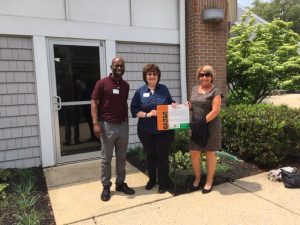 With the help of a Unity Gardens grant, the Severna Park Community Center recently replaced 23 non-native shrubs that were around the main building and at the front of the newly renovated historic 1927 Boone Station Hall with native shrubs and perennials. Volunteers from the local Good Neighbors Group, Girl Scout Troop 10346, SPCC facility users and the Woods church gardeners and REHABS (retired handypersons) groups replaced the non-native Nandina shrubs with native shrubs that provide flowers for early emerging pollinators as well as berries to serve the nutritional needs of our birds. The newly planted shrubs include Black chokeberries, American beautyberries, Arrowwood viburnums, New Jersey tea, Inkberries and Shrubby St. John’s wort. Perennials including Christmas ferns, Alumroot, Blue wood sedge and Black-eyed Susans were also planted to provide additional support for pollinators. The Community Center will now be part of the Maryland Pollinator Pathway.
With the help of a Unity Gardens grant, the Severna Park Community Center recently replaced 23 non-native shrubs that were around the main building and at the front of the newly renovated historic 1927 Boone Station Hall with native shrubs and perennials. Volunteers from the local Good Neighbors Group, Girl Scout Troop 10346, SPCC facility users and the Woods church gardeners and REHABS (retired handypersons) groups replaced the non-native Nandina shrubs with native shrubs that provide flowers for early emerging pollinators as well as berries to serve the nutritional needs of our birds. The newly planted shrubs include Black chokeberries, American beautyberries, Arrowwood viburnums, New Jersey tea, Inkberries and Shrubby St. John’s wort. Perennials including Christmas ferns, Alumroot, Blue wood sedge and Black-eyed Susans were also planted to provide additional support for pollinators. The Community Center will now be part of the Maryland Pollinator Pathway.
The Severna Park Community Center’s vision is to create “a healthy, connected community”, so connecting with the wildlife on the campus by planting beneficial native plants was a good step to take. With users from a wide geographic area, the Center now has the opportunity to be a role model for the use of native shrubs rather than non-natives. Information sheets about what was planted and why the new shrubs were chosen will be available for all. The Community Center thanks Unity Gardens for providing the means to make their grounds as welcoming to wildlife as their facility is to the many people who use the Center every day.

